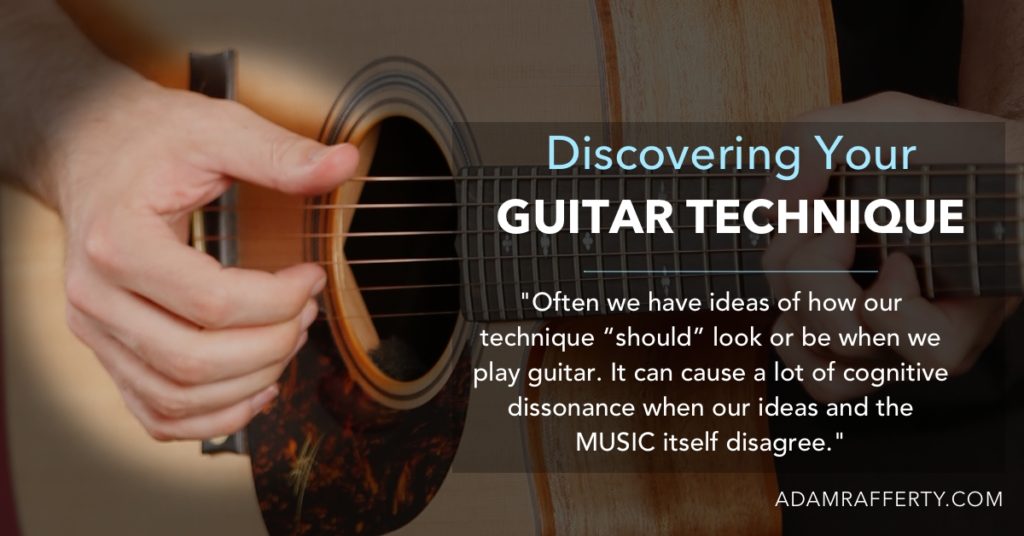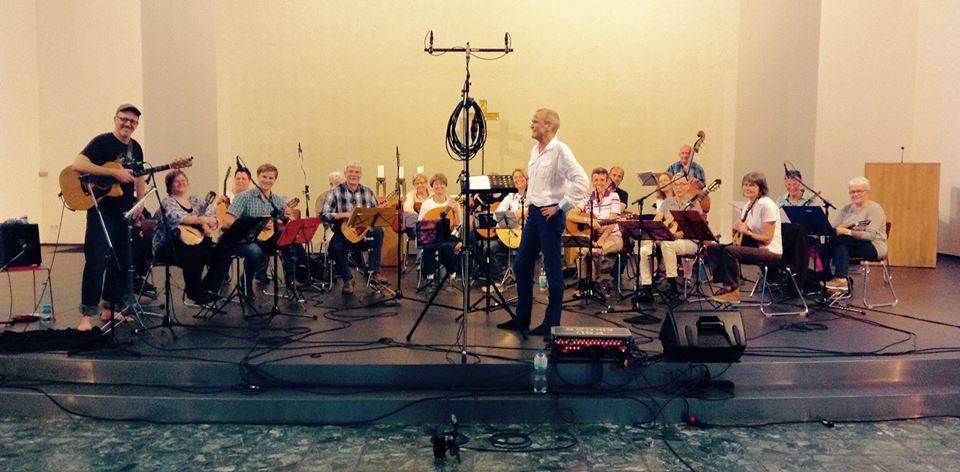
Often we have ideas of how our technique “should” look or be when we play guitar. It can cause a lot of cognitive dissonance when our ideas and the MUSIC itself disagree.
Hopefully this info will help you melt into mental, musical and spiritual grooviness.
The Scenario
Recently I played a classical piece (as the featured soloist) with a mandolin & guitar ensemble on my steel string guitar.
This was an exciting, exhilarating and scary thing to do!
It was not easy, especially for a funky finger style dude with no fingernails.
It was composed by a classical guitarist, and I think she wrote what feels natural on the guitar for her

(“Alamanda” composed by Annete Kuisbrink with the Grenzland-Zupforchesta, Aachen Germany. Josef, center was the conductor.)
The Dilemma
I found myself puzzled as I searched for the optimal right hand position and technique to play this piece. Passages like this with no fingernails are pretty darn tricky:

Some classical technique concepts I learned as a teen really helped me pull the piece off. They also helped me keep other hotel guests awake at midnight
After about 4 days of “woodshedding” I thought “AHA! Now I have really improved my right hand technique. I’ll bring this back to my finger style tunes for better clarity, speed, tone and precision.”
But…
Getting Back to Groove Meant Surrendering
It took me a day to get my “groove” back on pieces which I have played thousands of times, but I had to relinquish any technical changes I made and just go for groove only. Back to square one!
This brought up a lot of “cognitive dissonance” for me. To play my arrangements, I literally have to do things that would make a classical player barf.
I was looking for a “one size fits all” solution and started getting very pissed at my own,
weird, un-classical technique that I have gotten used to.
Then came the real AHA moment…
The dissonance of “I play like THIS, but it should be like THAT” melted into…
“What I do technically on Superstition is 100% correct for THAT piece. Other pieces may have different solutions, and that’s ok too!”
So..there is no absolute “correct” guitar technique, because it all depends on:
- the music you are playing
- the instrument you play
- the environment you are playing in
- the rhythmic behavior & concept of the music
It’s like wearing a tuxedo for a hike in the mountains. A tux can be perfect, mountains are perfect, but the two might not fit together too well.
The Takeaways?
- Independently investigate your own truth, don’t take anyone’s word for it
- “Discover” your own technique through music
- Find out what works for your playing and listen, listen listen
- Stay flexible from piece to piece…things can change, and they do!
My Personal AHA Takeaway
Allow YOUR highest value to determine everything. That may be a value of tone, clarity, melodicism, harmony.
For me it’s groove and the right tone
Then, the technique follows.
Please leave a comment below, your opinion and experiences are highly valued!

Very insightful as usual!@ Thanks for your thoughtful posts!
Very nicely written and said Adam. Our paths crossed briefly at a Frankfurt Music Fair. I will always remember your friendliness and kindness. Cheers
Great post Adam lots of food for thought!
Thank you so much, Adam, for this insight from a guitar phenom! As an intermediate player who has taken lessons from classical, pop, and jazz instructors, the cognitive dissonance that I have experienced with each instructor has kept me from knowing who I am as a player. I am so happy to hear your experience because I think I can now move forward in my practice with a greater sense of confidence that if I know how my fingers work and the way I’m playing is pleasing to me and others, that is the goal.
Linda
We usually start practicing a new song by learning the original recording. I have found that if I stop there (with a knock-off version) I am always disappointed with my performance. The reason: I am not the original performer and will never perform the piece the same as him. My performance is not genuine.
There is value learning to imitate the original STYLE, but not in imitating the original PERFORMANCE. Once you get the original down, note perfect, you have learned something of his style. Then you can play YOUR version with some of HIS style. That’s a winner, and you won’t feel like you’re trying to be in someone else’s skin.
Excellent post. thank you so much.